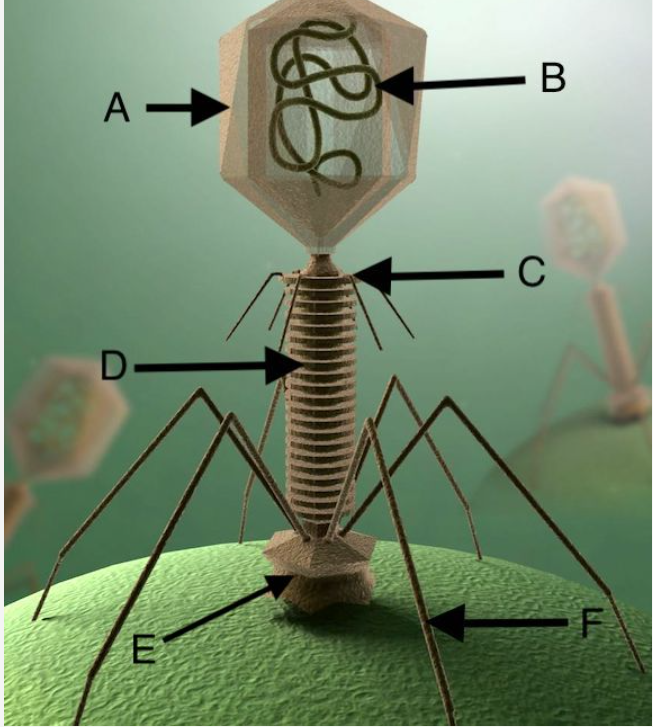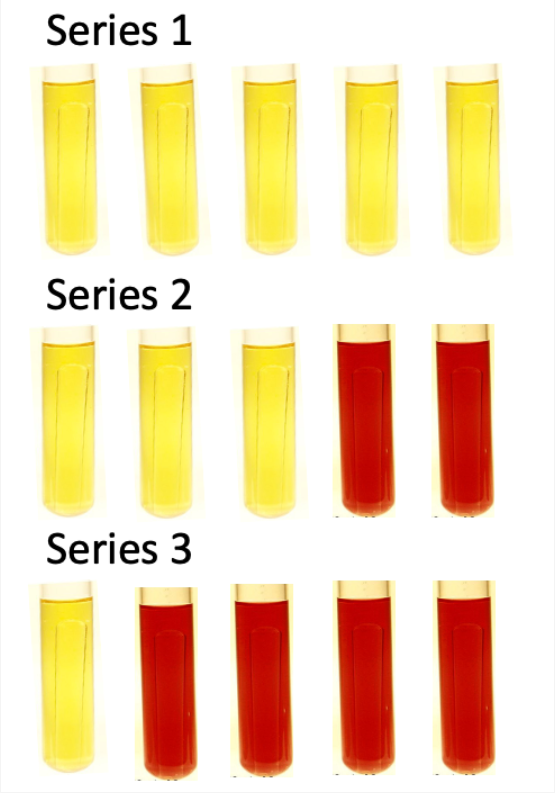Navigation » List of Schools, Subjects, and Courses » Bio 2010 – Microbiology » Lab Quizzes » Lab Quiz 3 » Lab Quiz 3 Sample Answers

Lab Quiz 3
1. This is an image of a T4 bacteriophage. Which of the following structures is indicated by “C”?

- capsomer
- collar
- sheath
- tail fiber
- base plate
2. From our antibiotic lab, which of the following was a good broad-spectrum antibiotic?
- ampicillin
- penicillin G
- tetracycline
- chloramphenicol
3. The tail fibers of a bacteriophage are most useful during which of the following stages of the lytic replication cycle?
- assembly
- synthesis
- attachment
- entry
- departure
4. Given the following information: 240 plaques, a 1:100 dilution and a sample volume = 0.1 ml, which of the following is the correct PFUs/mililiter?
- 2.4 X 102
- 2.4 X 103
- 2.4 X 104
- 2.4 X 105
- 2.4 X 106
5. You own a restaurant and are aware the one of the food items in your refrigerator is contaminated. You are curious to know which one it is before you throw it out. In order to do so, you blend up the following: raw chicken; cooked chicken; and beef bologna deli meat and place them into their own flask and dilute them into their own petri dishes with melted agar. You make 1:10, 1:100, 1:1000 & 1:10000 dilutions of each. After incubating the samples overnight you pick the following samples to measure: the cooked chicken sample with 32 CFUs (from the 1:10000 sample), the raw chicken sample with 420 CFUs (from the 1000 sample) and the beef bologna deli meat with 3590 CFUs (from the 1:100 sample). Which of the following indicates the sample that has BOTH the correct total number of CFUs AND MOST contamination?
- the cooked chicken with 3.2 X E5 CFUs/ml
- raw chicken with 4.2 X E5 CFUs/ml
- beef bologna deli meat with 3.59 X E5 CFUs/ml
- the cooked chicken with 3.2 X E6 CFUs/ml
- beef bologna deli meat with 5.39 X E6 CFUs/ml
6. From our antibiotic lab, which of the following antibiotics were both Staphylococcus epidermidis and Escherichia coli resistant to?
- ampicillin
- penicillin G
- tetracycline
- chloramphenicol
- more than one of the above is correct
- none of the above is correct
7. Using the Most Probable Number chart and the lactose broth tubes, which of the following is the total number of coliform units per liter?


- 1700 CFU’s/L
- 220 CFUs/L
- 1100 CFUs/L
- 900 CFUs/L
8. Which of the following genus and species of bacteria was the Most Probable Number indicator species?
- Staphylococcus epidermidis
- Bacillus subtilis
- Neisseria sica
- Escherichia coli
9. Which of the following statements concerning broad spectrum antibiotics is TRUE?
- they are used to treat Gram-positive and Gram-negative bacterial infections
- they are used to treat only Gram-positive bacterial infections
- they are used to treat only Gram-negative bacterial infections
- they are only used to treat spirilla bacteria
10. Each of the following features is common to both bacteriophage and animal virus infections, EXCEPT:
- attachment
- uncoating
- assembly
- penetration
Lab Quiz 3 Answer
1. B. collar
2. D. chloramphenicol
3. C. attachment

